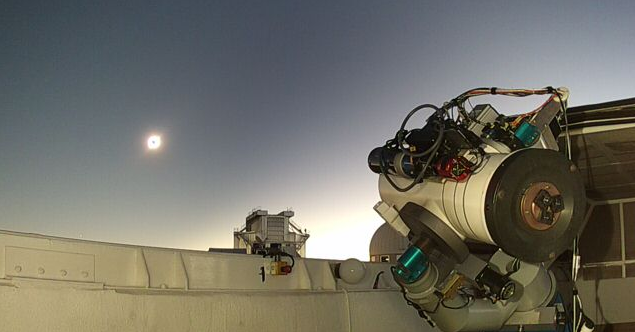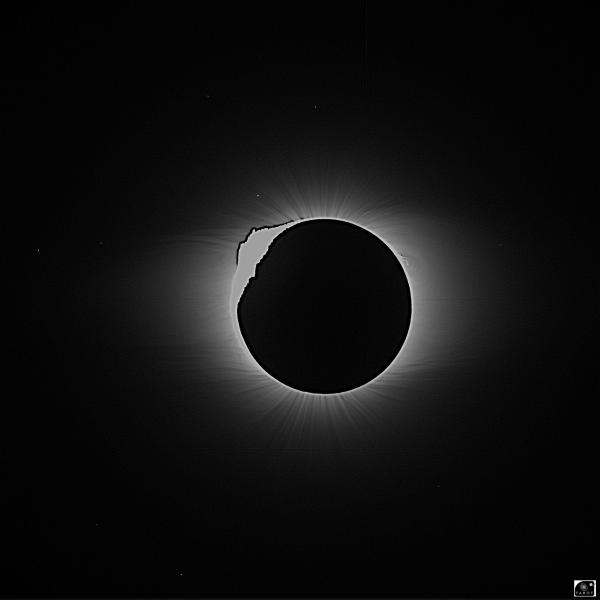Replay the Einstein eclipse with TAROT
One century ago, on 1919 May 29th the astronomer Arthur Eddington confirmed the prediction of Albert Einstein that the light is deflected by masses. Eddington used the Sun as mass deflector and nearby stars as targets to measure the light deflection. The experiment is feasible during a total eclipse of sun because the sky brightness drops to the level of twilight and some stars can be seen close to the sun.
Last July 2nd 2019 a total eclipse of Sun was observable at ESO/La Silla observatory, Chile.TAROTis a robotic telescopebuild by CNRS IRAP and DT-INSU. It wasinstalledatESO/la Sillain2006to study the early optical emission of gamma-ray bursts. We decided to use this telescope to replay the work done byEddingtonone century before. The measure is very challenging because we must determine positions of stars with an accuracy better than 0.0001 degree.

During the hour preceding the totality, the partial eclipse was recorded with TAROT using an additional aperture solar filter. This filter was manually removed just at the beginning of the totality. A software script was specially written to record images during the totality and to move away the telescope from the sun direction when the totality is finished. All the operations were repeated many times during the hours before the eclipse. The image acquisition was perfectly done during the eclipse (see Figure 1). A movie showing the live during the duration of 1m52s of the total eclipse can be seen at: https://youtu.be/wEiyvX9GEDI
First analysis of the images shows that stars are detected on images with exposure timesof 5s and 10s.The images of 1s does not saturate the corona but stars are almost undetectable. To illustrate the context of our experiment we synthesized an image using one 1s image and added only the stars visible on 5s and 10s images (see Figure 2).

Now we are waiting the observations of January 2020 to compare the same stars during the eclipse and during a night at the same local elevation.
Team TAROT for the 2019 eclipse: Alain Klotz (1,2), Adrien Nicolas Klotz (2), Jean-François Le Borgne (1), Eric Denoux (3,4), Christian Buil (4), Valérie Desnoux (4), Yoann Richaud (5), Rico Sautile (5), Xavier Regal (5), Julien Lecubin (6), Loic Eymar (7), Michel Boer (7).
- 1 IRAP-Observatoire Midi Pyrénées, Toulouse, France
- 2 Universite Paul Sabatier, Toulouse, France
- 3 Observatoire Cor Caroli, Caussade, France
- 4 Association AUDE, Paris, France
- 5 Observatoire de Haute Provence, OSU PYTHEAS, France
- 6 OSU PYTHEAS, France
- 7 ARTEMIS-CNRS/OCA/UNS, Nice, France
Acknowledgments
The TAROT telescopes were built and are maintained thanks to the technical and financial support of CNRS-INSU (ARTEMIS, IRAP), CNES and OSU Pytheas. We thank Vincent Megevan (Geneva observatory).
Further Resources
- Klotz A. et al. 2013, The Messenger 151, 6
- Video made by Guillaume Doyen : Dans l’ombre d’Einstein
IRAP Contact
- Alain Klotz, alain.klotz@irap.omp.eu






